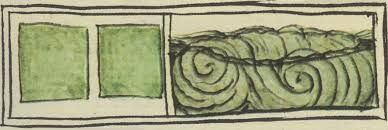"Aztec commoners ate only two meals--one in the mid-morning after working for a few hours, and one in the mid-afternoon, when the sun was hottest. The common Aztec ate only two or three tortillas and a serving of beans at each meal. One might also partake of a nighttime snack of amaranth gruel...Aztgec commoner did not live by maice and beans alone. Tomatoes, avocadoes, and several varities of squash presented more choices at a mela. Chili peppers were used to flavor meals...Ants, grasshoppersm maguey worms, and jumil bugs, all available in large quantities, provided protein. Commoners gathered tequitlatl (blue-green spirulina algae) in large fine nets to provide large harvests of protein...Cacao was a popular drink among the royal classes and it was a valuable commmodity."
---Handbook To Life in the Aztec World, Manuel Aguilar-Moreno [Oxford University Press:Oxford] 2007 (p. 371, 373)
Sunday, March 18, 2012
Thursday, June 2, 2011
Wednesday, April 13, 2011
Comal pic
comal
Traditional Comal
The traditional comal native of Mexico is basically a disk or oval medium-sized plane (about 30 cm ) made of ceramic fired, placed on three or four stones (called Tenamaxtlán ), which serve to provide support and to turn fire and coals just below the pan.
the Aztecs living on Lake Texcoco ate a blue-green cake called tecuitlatl /spirulina


the Aztecs living on Lake Texcoco ate a blue-green cake called tecuitlatl /spirulina
Tuesday, April 12, 2011
chilli "Chili pepper"
chilli "Chili pepper"
- Chili pepper contains impressive list of plant derived chemical compounds that are known to have disease preventing and health promoting properties.
- Chillies contain health benefiting an alkaloid compound in them, capsaicin which gives strong spicy pungent character. Early laboratory studies on experimental mammals suggest that capsaicin has anti-bacterial, anti-carcinogenic, analgesic and anti-diabetic properties. It also found to reduce LDL cholesterol levels in obese individuals.
- Fresh chili peppers, red or green, are rich source of vitamin-C. 100 g fresh chilies provide about 143.7 mcg or about 240% of RDA. Vitamin C is a potent water soluble antioxidant. It is required for the collagen synthesis in the body. Collagen is the main structural protein in the body required for maintaining the integrity of blood vessels, skin, organs, and bones. Regular consumption of foods rich in vitamin C helps body protect from scurvy; develop resistance against infectious agents (boosts immunity) and scavenge harmful, pro-inflammatory free radicals fro the body. helps remove harmful free radicals from the body.
- They are also good in other antioxidants like vitamin A, and flvonoids like beta carotene, alpha carotene, lutein, zeaxanthin, and cryptoxanthins. These antioxidant substances in capsicum helps to protect body from injurious effects of free radicals generated during stress, diseases conditions.
- Chillies contain good amount of minerals like potassium, manganese, iron, and magnesium. Potassium in an important component of cell and body fluids that helps controlling heart rate and blood pressure. Manganese is used by the body as a co-factor for the antioxidant enzyme superoxide dismutase.
- Chillies are also good in B-complex group of vitamins such as niacin, pyridoxine (vitamin B-6), riboflavin and thiamin (vitamin B-1). These vitamins are essential in the sense that body requires them from external sources to replenish.
Chilli peppers have amazingly high levels of vitamins and minerals. Just 100 g provides (in % of Recommended daily allowance)
240% of vitamin-C (Ascorbic acid),
39% of vitamin B-6 (Pyridoxine),
32% of vitamin A,
13% of iron,
14% of copper,
7% of potassium,
39% of vitamin B-6 (Pyridoxine),
32% of vitamin A,
13% of iron,
14% of copper,
Nopales
Nopales, raw
1 cup
Nopales are very rich in insoluble and especially soluble dietary fiber. They are also rich in vitamins (especially vitamin A, vitamin C, and vitamin K, but also riboflavin and vitamin B6) and minerals (especially magnesium, potassium, and manganese, but also iron and copper). Nopales have a high calcium content, but the nutrient is not biologically available because it is present as calcium oxalate, which is neither highly soluble nor easily absorbed through the intestinal wall.[3] Addition of nopales also reduces the glycemic effect of a mixed meal.[4] Nopales are low carbohydrate and may help in the treatment of diabetes.[5]
Amounts Per Selected Serving
Minerals %DV
Calcium 141mg 14%
Iron 0.5mg 3%
Magnesium 44.7mg 11%
Phosphorus 13.8mg 1%
Potassium 221mg 6%
Sodium 18.1mg 1%
Zinc 0.2mg 1%
Copper 0.0mg 2%
Manganese 0.4mg 20%
Selenium 0.6mcg 1%
Pepitas
Pumpkin Seeds
Pumpkin Seeds May Promote Prostate Health
DHT (dihydrotestosterone). Components in pumpkin seed oil appear able to interrupt this triggering of prostate cell multiplication by testosterone and DHT, although the exact mechanism for this effect is still a matter of discussion
Pumpkin Seed Phytosterols Lower Cholesterol
Phytosterols are compounds found in plants that have a chemical structure very similar to cholesterol, and when present in the diet in sufficient amounts, are believed to reduce blood levels of cholesterol, enhance the immune response and decrease risk of certain cancers.A Rich Source of Healthful Minerals, Protein and Monounsaturated Fat
good source of the minerals magnesium, manganese and phosphorus, and a good source of iron, copper, protein, and as previously mentioned, zinc. Snack on a quarter-cup of pumpkin seeds and you will receive 46.1% of the daily value for magnesium, 28.7% of the DV for iron, 52.0% of the DV for manganese, 24.0% of the DV for copper, 16.9% of the DV for protein, and 17.1% of the DV for zinc.
Anti-Inflammatory Benefits in Arthritis
Protection for Men's Bones
-180 moderately inflammatory
Subscribe to:
Posts (Atom)
